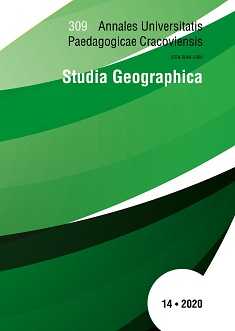Stages of feminisation in the teaching profession: examples from selected countries
DOI:
https://doi.org/10.24917/20845456.14.9Keywords:
effective feminisation; stagnant feminisation; regressive phase; typification transition; professional typificationAbstract
Feminisation of the teaching profession is a global and ongoing process. This phenomenon progresses at different speeds and takes on various forms and, thus, can be divided into specific stages. The paper focuses on examining feminisation as a phased process. Its foundation are absolute numbers of teachers of both genders and relative values, i.e. the share of men and women in the teaching population and relationships between them, analysed over time. During the course of the investigation it turned out that a phased approach proved useful in analysing the speed and nature of professional typification of teachers. The analysis of the collected data led to a conclusion that the feminisation of the teaching profession in Europe in the years 2005-2017 was in some cases very dynamic and comprised of two or three stages within the twelve-year period and, on the other hand, in some countries the process was less varied and presented a single stage of the profession’s typification.
References
Bednarska M., (2009). Feminizacja zawodu. Edukacja i Dialog, II/2009, dostępny na: http://www.eid.edu.pl/archiwum/2009,261/luty,274/temat,281/feminizacja_zawodu,2148.htm.
Bongco, R., Abenes, R. (2019). Clash of Spheres – The Paradox of Being a Female Teacher in the Philippines. Beijing International Review of Education, 1, 443–459.
Cacouault-Bitaud, M. (2001). Is the feminization of a profession a loss of prestige? Travail, genre et sociétés, 1 (5), 91–115. DOI 10.3917/tgs.005.0091
Czaja-Chudyba, I., Drwal, B., Włoch, M. (2017). Mężczyzna jako nauczyciel edukacji wczesnoszkolnej. Pedagogika Przedszkolna i Wczesnoszkolna, 5 (2/2) (10/2), 19–33.
Czarnik S., Kasparek K. (2015). Segregacja płciowa na polskim rynku pracy. W: J. Górniak (red.), (Nie)wykorzystany potencjał. Szanse i bariery na polskim rynku pracy. Warszawa: PARP.
Czarnik, Sz., Turek, K. (2012). Aktywność zawodowa Polaków. Praca zawodowa, wykształcenie, kompetencje. Warszawa: PARP.
Cushman, P. (2005). Let’s hear it from the males: Issues facing male primary school teachers. Teaching and Teacher Education, 21, 227–240.
Dudak, A, (2016). Wybrane aspekty funkcjonowania mężczyzn w zawodach sfeminizowanych. Problemy Profesjologii, 2, 23-32.
Ferrie J., Riddell S., & A Stafford. (2006). Undergraduates’ views of teaching as a career. In: S. Riddell , L. Tett (Eds.), Gender and Teaching. Where have All the Men Gone? (pp. 32–44). Edinburgh: Dunedin Academic Press.
Fike, R.A. (2016). Where Have All the Teachers Gone? A Gendered Analysis of the Teaching Occupation. Honors Thesis; Department of Political Science.
Fudali, R., Kowalski, M. (red.). (2006). Kobieta i mężczyzna w zawodzie nauczycielskim. Kraków: Oficyna Wyd. Impuls.
Gromkowska-Melosik A., (2013). Feminizacja zawodu nauczycielskiego – „różowe kołnierzyki” i paradoksy rynku pracy. Studia Edukacyjne, 25, 85–100.
Griffiths, M. (2006). The feminization of teaching and the practice of teaching: threat or opportunity? Educational Theory, 56(4), 387–405.
Kabalski, P., Szwajcar, J. (2015). Feminizacja studiów w zakresie rachunkowości w Polsce-przyczyny i skutki. Zeszyty Teoretyczne Rachunkowosci, 81(137), 85–106.
Klimczak-Ziołek J. (2005). Bibliotekarz jako zawód sfeminizowany – przyczyny i skutki. W: Z. Dacko-Pikiewicz, M. Chmielowska (red.), Rola biblioteki narodowej w tworzeniu społeczeństwa wiedzy. Dąbrowa Górnicza: WSB.
Kopka, J. (1986). Skutki feminizacji zawodu nauczycielskiego. Przegląd Socjologiczny, 34(1), 121–133.
Kuzitowicz, W. (2012). Nasza Pani czy Nasz Pan? Refleksje nad rolą praktyk pedagogicznych w przełamywaniu stereotypów płciowych w odniesieniu do nauczycielek i nauczycieli edukacji wczesnoszkolnej. W: Dobre praktyki pedagogiczne szansą innowacyjnej edukacji. Łódź: Wydawnictwo Naukowe WSP w Łodzi, 77–86
Milerski, B., Śliwerski, B. (2000). (red.) Pedagogika. Leksykon PWN. Warszawa: Wyd. Naukowe PWN, 65.
Piróg, D. (2012). Poziom zainteresowania pracą w zawodzie nauczyciela wśród studentów geografii. Prace Komisji Edukacji Geograficznej Polskiego Towarzystwa Geograficznego, 2, 193–210.
Piróg, D. (2014). W poszukiwaniu metodologicznych innowacji w badaniach jakościowych – przykład z analiz przechodzenia absolwentów geografii na rynek pracy. Annales Universitatis Paedagogicae Cracoviensis Studia Geographica, 6, 162, 9–19.
Piróg, D., Hibszer, A. (2020). The situation of geography teachers on the labour market in Poland: overt and covert issues. European Journal of Geography (w druku).
Pokrzywa, M. (2016). Feminizacja zawodu pracownika socjalnego. Medzinárodná interdisciplinárna vedecká konferencia, Prešov, 7. 11. 2016, 154–164.
Rahayani, Y. (2010). Feminization of teaching. Journal of English and Education, 4(2), 13–24. DOI: https://doi.org/10.20885/jee.vol4.iss2.art2
Reszke, I. (1991). Nierówności płci w teoriach: teoretyczne wyjaśnienia nierówności płci w sferze pracy zawodowej. Polska Akademia Nauk. Instytut Filozofii i Socjologii.
Sari, M., Basarir, F. (2016). Analyzing teachers’ perceptions of “female teacher” and “male teacher” within traditional gender roles. International Journal of Education and Research, 4(3), 205–224.
Schmude, J., Jackisch, S. (2019). Feminization of Teaching: Female Teachers at Primary and Lower Secondary Schools in Baden – Wurttemberg, Germany: From Its Beginings to the Past. W: H. Jahnke, C. Kramer, P. Meusburger (red.), Geographies of schoolong, Knowledge and Space, 14, 333–349.
Smak, M., Walczak, D. (2017). The prestige of the teaching profession in the perception of teachers and former teachers. Edukacja. An interdisciplinary approach, 2 (141), 22–40.
Stanonik, M. (2015). Education and feminization of the teaching profession. W: M. Godawa, S. Gerjolj (eds.), Faces of Women. Kraków, 113–123. DOI: http://dx.doi.org/10.15633/9788374384919.10
Tašner, V., Žveglic M., M; Mencin C., M., (2017). Gender in the teaching profession: university students’ views of teaching as a career. CEPS Journal, 7(2), 47–69.
https://stats.oecd.org/Index.aspx?datasetcode=EAG_PERS_SHARE_AGE#.
Downloads
Published
Issue
Section
License
The submission of a paper to be published is synonymous with an agreement to transfer the copyright free of charge from the author to the publisher. The author also agrees to permit the publisher to publish the paper in printed form, open access online form, digital library form and other digital platforms with which the publisher has or will have a publishing agreement. Furthermore, the author agrees to not limit the number of copies that may be printed or issued by the publisher. In the case of co-authored papers, it is assumed that the corresponding author is authorized to represent the remaining co-authors in this respect. Authors are requested to sign a copyright declaration.

